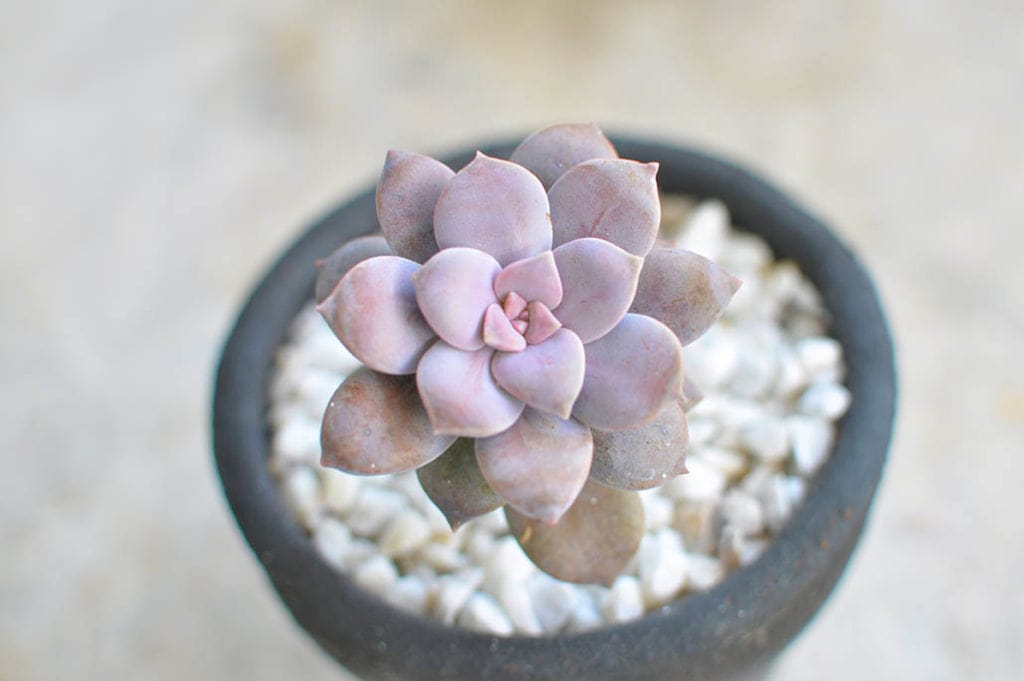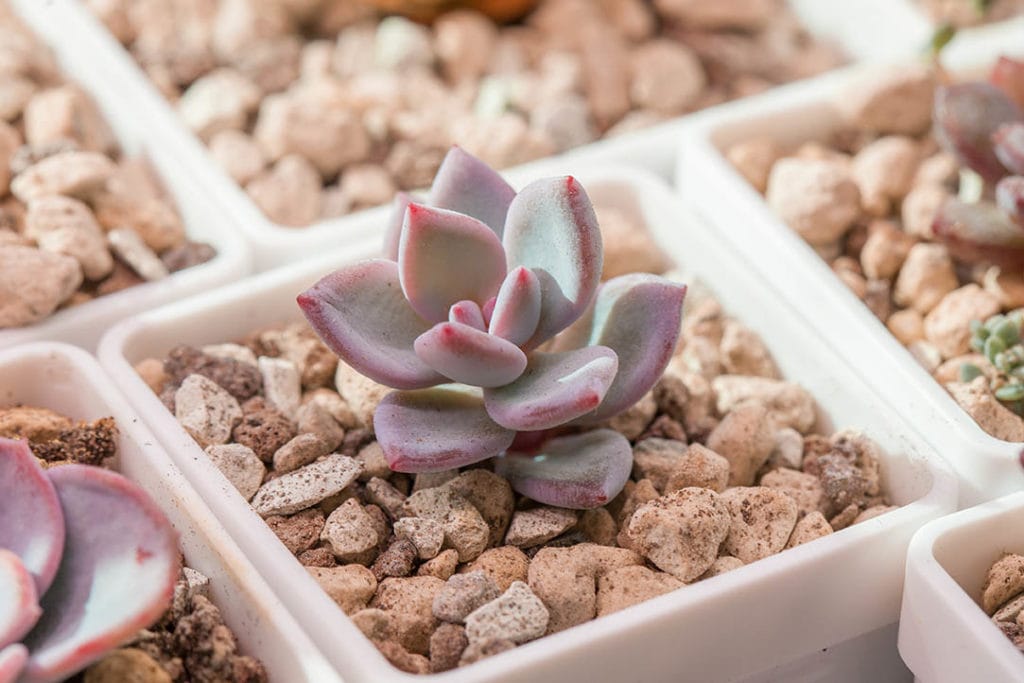20 Types of Blue Succulents (With Pictures)
-
Pete Ortiz
- Last updated:

A garden or houseplant collection looks amazing when there are lots of colors. Blue succulents with impressive rosettes can be an excellent addition to your plant collection. Most of these plants are low maintenance and only require well-draining soil and light exposure to thrive.
In this article, we discuss some of the blue succulents that do well in cold or warm conditions. The succulents also vary in terms of the height and diameter of the plants. Let’s look at some popular blue succulents for your home this year.
The 20 Most Common Types of Blue Succulents
1. Blue Elf Aloe
Succulents like Blue Elf Aloe can thrive even in droughts. Their preferred USDA hardiness zones are 9 through 11 if you want to grow them outside in areas with extensive sun exposure.
This type of aloe grows in tight clumps and can reach a height of 18 inches and spread 2 feet wide. It has narrow, blue-gray leaves that point upward with orange spikes on the edges.
It’s possible to grow this succulent indoors or in pots, provided you get well-draining soil. You can also use it as a ground-cover plant.
2. Dudleya Anthonyi
This succulent originates from Baja, California. It thrives in well-draining soil and has sharp and narrow leaves and petals that are blue in color.
A little patience is necessary in terms of growth rate since this plant takes time to mature. Any large clumps you come by out in the wild might have taken years to grow.
The Dudleya Anthonyi plant blooms in the spring and produces large flower stalks from each rosette.
3. Echeveria Blue Alice
The Echeveria Blue Alice succulent grows in the shape of a rosette with pastel-blue leaves and red margins. In spring, the succulent produces stalks with red and orange flowers.
These succulents do well in USDA hardiness zone 10. If placing them indoors, consider a spot with direct sunlight to maintain the rosette’s shape and blue color.
Avoid planting Echeveria Blue Alice outside if the area gets lots of frosts.
4. Echeveria Blue Minima
The Echeveria Blue Minima originates from the arid areas in Mexico and grows in tight clusters. In terms of color, the succulent is blue-green and produces small, orange bell-shaped flowers in the spring. The blue tone is more vibrant when there’s lots of sunshine.
USDA hardiness zones 9b to 11b suit the Echeveria Blue Minima succulent. Place it in an area with lots of direct sunshine, but ensure you add some protective measures to guard against frost at night.
The plant can grow up to 5 inches tall and form chubby, blue rosettes with pinkish tips.
5. Mangave Tooth Fairy
The Mangave Tooth Fairy is a cross between Manfreda and Agave. It originates in North America and is one of the fastest-growing succulents.
It has bluish-green leaves with spines that are a rainbow of colors, including orange and red. The leaves are thick and form a single rosette. The blooming season takes place in late spring to early summer.
This succulent thrives in dry areas with well-draining soil but can also grow indoors. USDA hardiness zones 9 to 10 work best when growing this plant outdoors. Most plants will achieve a height of 1 to 3 inches.
6. Orastachys Boehmeri
The Orastachys Boehmero is also called the Chinese Dunce Cap and originates from Japan. It is a lovely succulent suitable for both indoor and outdoor spaces. The succulent has attractive, lavender-grey leaves that form soft rosettes. Each rosette can spread to 2 inches in diameter.
The Chinese Dunce Cap thrives in USDA hardiness zones 6a to 10b. It’s not a stickler for proper soil, provided it gets the essentials when grown in a pot.
You’ll be delighted to know that this succulent can survive freezing temperatures—some even keep growing at -30° Fahrenheit.
7. Moonstones
Add some moonstones to your succulent collection. This plant has small, chubby leaves that are unique and attractive. It is a low-maintenance succulent that can grow in any type of well-draining soil.
Moonstones can grow up to 4 inches tall and spread as far as 11 inches wide. Each stem is white and can hold up to 15 leaves. The egg-shaped leaves often have a blue, green, or purple hue.
If you want the plant them indoors, pick a spot that gets lots of sunlight. Outside, the succulent can grow in partial or direct sunlight. It does well in USDA hardiness zones 10a to 11b.
8. Powdered Jewel Plant
The Powdered Jewel succulent has short stems that support its small rosettes. The rosettes measure 2.4 inches and have fleshy, blue-gray leaves with pointy tips.
The plant does well in USDA hardiness zones 9a to 11b. However, it’s better to grow it inside if you’re in a frost-prone location.
It’s possible to grow the Powdered Jewel Plant in pots as long as you water them sparingly. Always allow the soil to dry out completely before watering again. The succulents will bloom in spring and showcase stunning orange and red flowers.
9. Powder Puff

Enjoy the beautiful Powder Puff hybrid with its noticeable silver-blue leaves. Each leaf has attractive pink tips that get deeper in color when exposed to full sun.
USDA hardiness zone 10a is ideal for the Powder Puff succulent when grown outdoors because it’s not a cold-hardy plant.
10. Sadeveria Blue Mist
Blue Mist succulents are low-growing plants that are perfect for adding to your collection. These succulents originate from Mexico and do well as house plants or outdoor plants. The succulents tend to be evergreen and produce flowers from short stalks.
The Blue Mist plant has compact rosettes with blue and purple leaves. The longer they are exposed to the sun, the darker the shade of purple the leaves will become. They do well in USDA hardiness zones 9a to 11b.
Each succulent can grow 4 inches long and 3.4 inches wide. Be careful not to overwater them if you decide to add them to your collection.
11. Pacific Blue Ice
The Pacific Blue Ice succulent originates from Western Asia and Southern Europe. It has rounded rosettes that tend to form mats. These perennial plants have icy-blue, plump leaves. It can grow as tall as 4 inches and spread up to 8 inches wide.
Always keep the Pacific Blue Ice in full sun and well-draining soil. USDA hardiness zone 5a is its ideal outdoor location.
The Pacific Blue Ice is hardy in cold weather and requires minimal maintenance once you spot new growth.
12. Blue Chalksticks
Blue Chalksticks are small, low-growing succulents with an attractive shape and color. It grows fleshy, silvery-blue leaves and can reach heights up to 18 inches tall. This plant produces white flowers in the spring and grows mainly in the winter while being dormant in the summer.
Clue Chalksticks are best for USDA hardiness zones 10 to 11 or anywhere will exposure to at least 6 hours of direct sunlight.
You can grow the Blue Chalksticks outside in a rock garden or in containers indoors.
13. Butterfly Agave
Here’s an example of another blue succulent that originates from Japan. It’s an evergreen perennial that forms perfectly symmetrical rosettes with soft, silvery-blue leaves.
A single Butterfly Agave can grow to be 15 inches tall and 18 inches wide when fully mature. Blooms happen as the temperature drops in late fall or early winter.
Keep the succulent in an area with exposure to plenty of sunlight if growing them as houseplants. If growing them outside, they can grow in partial shade or full sunshine in all soil types.
14. Aloe Blue Sky
This blue succulent is a hybrid plant. A mature Aloe Blue Sky plant can be 12 inches tall and 15 inches wide. It tolerates drought and can be grown as a houseplant with minimal care.
The Aloe Blue Sky forms compact rosettes with orange spines along the margin of the leaves. USDA hardiness zones 9a to 11b suit the Aloe Blue Sky best.
15. Dudleya Brittonii
This plant is also known as the Giant Chalk Dudleya and is native to northern parts of Baja California. This succulent is an evergreen plant with giant, single-standing rosettes with grayish-blue leaves. A mature plant can grow 18 inches tall and 17 inches wide.
You can grow this succulent in a container as a solitary plant, but it’s also ideal for rock gardens. The giant succulent suits USDA hardiness zones 9 to 12 where it can get full sun and well-draining, sandy soil.
- Related Read: 40 Types of Purple Succulents (With Pictures)
16. Echeveria Blue Bird
Echeveria Blue Bird is another succulent from the Echeveria family. It has a striking beauty with its thick rosettes and fleshy blue leaves. Each leaf has a powdery coating and a pink tip.
A fully mature succulent can grow to reach 10 inches in diameter. However, they can remain small if you allow the offsets to clutter around them.
These plants are very tender and prone to dying due to frost. USDA hardiness zones 9b to 11b are the ideal growing zones. Leave the plant near a south-facing window with sufficient sun penetration if placed indoors.
17. Echeveria Blue Prince
You can add some Echeveria Blue Prince to your succulent collection as well. This succulent tends to grow in tight rosettes with blue-green leaves. As the plant matures, they tend to have a bronze hue and gets yellow flowers during the blooming season.
Echeveria Blue Prince plants are ideal houseplants but also do well outside. Use well-draining soil since overwatering can easily kill them. They
thrive in USDA hardiness zones 10a to 11b and are not tolerant of the cold.
18. Blue Spruce Stonecrop
This plant is among the best options when seeking standalone, hardy succulents. The Blue Spruce is a low-maintenance plant with stiff, needle-like leaves. When the temperature drops, the once blue leaves will turn salmon pink.
Blue Spruce succulents do well in full sun and USDA hardiness zones 4 to 10. They reach a maximum height of 8 inches but grow quickly and can easily overwhelm other plants in the area.
While they can survive droughts, they are also hardy enough for cold weather and can grow in areas that receive frost.
Related Read: 23 Types of Fuzzy Succulents (With Pictures)
19. Pachyveria Blue Belle
Purchase some Blue Belle succulents if you enjoy blue leaves with pink blooms in the spring. This is an evergreen variety with striking foliage and thick rosettes. The maximum size is 6 inches tall and 8 inches wide.
Blue Belle thrives in USDA hardiness zones 9a to 12. If growing them outside, it’s better to not water them. However, keep the plants in full sun outdoors and indirect sunlight inside the house.
20. Pachyveria Jeweled Crown
There’s no limit to the number of blue succulents you can grow. For example, the Jeweled Crown forms a powdery-blue rosette. The leaves are thick with blush-colored edges that are more pronounced with exposure to lots of sunlight.
The Jeweled Crown reaches a maximum height of 8 inches and width of 6 inches. It’s suitable for USDA hardiness zone 10 and can grow well indoors.
These plants also tolerate poor soil conditions and drought, requiring minimal watering.
Conclusion
There’s a wide variety of blue succulents that you can add to your plant collection. These are easily grown indoors or outside as long as the plants get the right conditions.
Keep in mind that blue succulents have many needs. Most species do well when placed in an area with sufficient light while inside and direct light while outside. They aren’t too picky when it comes to soil types and can grow in rock gardens with minimal watering needs. By bringing a few of these plants home, you can make your home’s aesthetic more pleasing without spending too much time caring for them.
See Also:
Featured Image Credit: Daydreamr Digital Studio, Shutterstock
Contents


